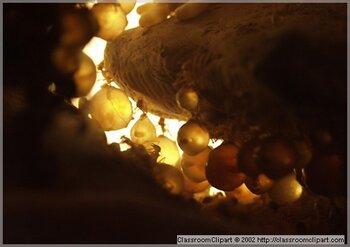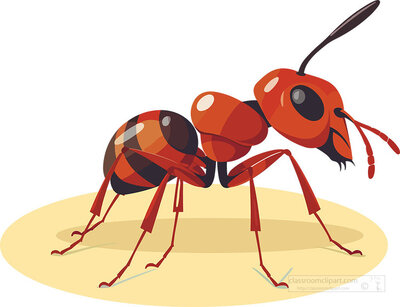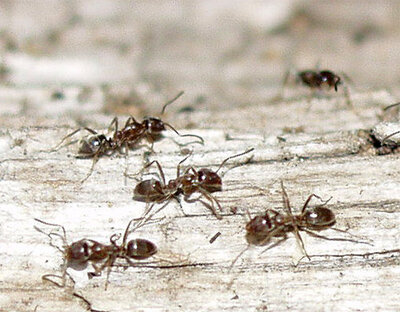Ant
|
|
| Ants | ||||||||||||
|---|---|---|---|---|---|---|---|---|---|---|---|---|
| Scientific classification | ||||||||||||
|
The ants, one of the most successful groups of insects, are of particular interest because they form advanced colonies. Ants, belonging to the family Formicidae, are among the most widespread and successful insects on Earth. Characterized by their highly organized colonies and distinctive social behavior, ants can be found in almost every terrestrial habitat. The most distinctive feature of ants is their eusocial structure, a high level of social organization where tasks are divided among different types of individuals, such as workers, soldiers, and queens.
| Contents |
Physical Description
Ants exhibit a wide range of sizes, colors, and body structures, typically measuring between 0.08 to 1 inch. Their bodies are divided into three segments: the head, thorax, and abdomen, with a narrow waist (pedicel) between the thorax and abdomen. Ants possess strong mandibles used for carrying food, digging, or defense. Their color can vary from black, brown, red, to even green or blue in some species. Some species have wings, especially during mating flights
Habitat and Distribution
Ants thrive in various habitats, from rainforests to deserts. They are terrestrial and often build nests in soil, under rocks, or in trees. The global distribution of ants is vast, covering every continent except Antarctica. Each species has adapted to specific environmental conditions, influencing their distribution and abundance.
Diet and Hunting Behavior
Ants are mostly omnivorous, feeding on a variety of plant and animal matter. Their diet includes nectar, seeds, fungi, or insects. Some species, like leafcutter ants, cultivate fungi, which they feed on exclusively. Ants employ various methods for obtaining food, including foraging, farming, and hunting. They communicate and coordinate their efforts through pheromones, enabling them to efficiently locate and gather food.
Reproduction and Lifecycle
In ant colonies, reproduction is primarily the queen's role, with some species having multiple queens. Males, produced by the queen, typically have only a single role: mating with the queen. After mating, males usually die. The queen lays eggs, which develop into larvae, pupae, and eventually adult ants. The care of young and the maintenance of the colony are tasks performed by worker ants. The lifespan of ants varies significantly, with workers living for a few months to a year, while queens can live for decades in some species.
Behavior and Social Structure
Ants are known for their complex social structure. A typical colony includes the queen, males, and numerous workers. Worker ants are further divided based on their roles, such as foragers, nurses, or soldiers. Daily activities in an ant colony are highly structured and can include foraging, nest maintenance, and caring for the young. Some species exhibit behaviors like migration or hibernation under adverse environmental conditions.
Conservation Status
Most ant species are not endangered and are, in fact, among the most dominant insects in their ecosystems. However, habitat destruction and climate change can impact specific ant populations. Some species are considered pests, particularly when they invade human spaces or agricultural areas.
Interesting Facts
- Ants can lift 20 times their body weight.
- Some species, like the army ants, do not have a permanent home, creating temporary nests as they move.
- Ants communicate using chemicals called pheromones, which can convey complex messages.
Development
Ants, members of the family Formicidae, display one of the most fascinating developmental processes in the insect world. This journey from egg to adult is a complex and meticulously orchestrated process, pivotal in maintaining the highly structured and efficient colonies that ants are known for.
Egg Stage
The beginning of an ant's life starts as an egg. Ant eggs are tiny, often oval-shaped, and require a stable, nurturing environment to develop. The queen ant, the primary egg-layer in the colony, can lay thousands of eggs in her lifetime. The fate of these eggs, whether they become workers, soldiers, or future queens, is often determined by the colony's needs and environmental factors.
Larval Stage
Once hatched, the ant enters the larval stage. Ant larvae are legless and helpless, entirely dependent on the worker ants for nourishment and care. This stage is crucial, as the larvae undergo significant growth. The diet provided by the worker ants during this phase plays a pivotal role in determining the larva's future caste – worker, soldier, or queen. Larvae are fed through a process called trophallaxis, where workers regurgitate food to feed them.
Pupal Stage
Following the larval stage, ants enter the pupal stage. During this phase, they encase themselves in a protective cocoon (in some species) and undergo metamorphosis. It's in this stage that the ant's physical features, like wings in the case of future queens and males, develop. The pupal stage is a time of transformation, where the ant transitions from its larval form to its adult form.
Adult Stage
The final stage in an ant's development is adulthood. Once emerged from the pupal stage, the ant is fully formed. The role of the adult ant is predetermined by its caste. Worker ants, which are sterile females, take on responsibilities like foraging for food, caring for the young, and maintaining and defending the colony. Male ants, often referred to as drones, primarily serve to mate with the queen. The queen's primary role is to lay eggs, ensuring the survival and expansion of the colony.
Social Structure and Roles
Ant colonies exhibit a sophisticated social structure, with each caste playing a specific role. The division of labor is not only essential for the colony's survival but also influences the development of individual ants. For instance, the transition of a worker ant's role from nursing to foraging is a critical aspect of its development and is crucial for the colony's functioning. Ants undergo complete metamorphosis, progressing through larval and pupal stages before reaching adulthood. The larval stage is characterized by the absence of legs, as it does not need to fend for itself. The future roles of ants, whether as queens or workers, and the various worker subtypes, are shaped by their nourishment during the larval phase. Larvae are fed through trophallaxis, a process where an ant regurgitates food stored in its crop. This method is also employed by adult ants to share food
Newly matured workers initially focus on caring for the queen and the young. Their roles evolve swiftly, progressing from nest construction to foraging and defending the nest, forming what are known as temporal castes. In some species, physical castes also exist, with workers varying in size – minor, media, and major. The larger workers, often with proportionally bigger heads and mandibles, are sometimes termed "soldier" ants due to their enhanced combat capabilities. However, their responsibilities typically align with those of other workers. In certain species, the median worker caste has vanished, accentuating the physical distinction between minor and major workers.
Reproduction in common ant species follows a consistent pattern. Initially, all ants in a colony are female, with only the queen and select females capable of mating. Male ants, or drones, along with breeding females, are winged and lead a life focused on consumption until mating season. During this period, these ants are released from the colony, coinciding with similar events in other colonies. Mating occurs mid-flight, after which males perish. Surviving females land, shed their wings, and start new colonies. They lay eggs and care for them. The first generation of workers, though weaker and smaller, immediately contribute to the colony's growth by expanding the nest, foraging, and tending to subsequent eggs. This cycle marks the beginning of a new ant colony.

Communication and behaviour
Ant communication is primarily through chemicals called pheromones. Because most ants spend their time in direct contact with the ground, these chemical messages are more developed than in other Hymenopterans. So, for instance, when a forager finds food on its way home (found typically through remembered landmarks and the position of the sun), it will leave a trail along the ground, which in a short time other ants will follow. When they return home they will reinforce the trail, bringing other ants, until the food is exhausted, after which the trail is not reinforced and so slowly dissipates. A crushed ant will emit an alarm pheromone, that in high concentration sends other ants nearby into an attack frenzy, and in lower concentration attracts them, while a few ants use what are called propaganda pheromones to confuse their enemies.
Like other insects, ants smell with their antennae, which are long and thin. These are fairly mobile, having a distinct elbow joint after an elongated first segment, and since they come in pairs they provide information about direction as well as intensity. Pheromones are also exchanged as compounds mixed in with the food interchanged in trophallaxis, giving the ants information about one another's health and nutrition. Ants can also detect what task group (e.g. foraging or nest maintenance) other ants belong to. Of special note, the queen produces a special pheromone without which the workers will begin raising new queens.
Ants attack and defend themselves by biting, and in many species, stinging, in both cases sometimes injecting chemicals into the target. Of special note here is formic acid.
Types
There is a great diversity among ants and their behaviors. See list of ant genera (alphabetical) for an alphabetical compendium of worldwide ant genera.
Symbiotic relationships with ants
- Aphids secrete a sweet liquid called honeydew. Normally this is allowed to fall to the ground, but around ants it is kept for them to collect. The ants in turn keep predators away and will move the aphids around to better feeding locations.
- Myrmecophilous or ant-loving caterpillars (blues, coppers, or hairstreaks) are herded by the ants, led to feeding areas in the daytime and brought inside the ants nest at night. The caterpillars have a gland which secretes honeydew if the ants massage them.
- Some myrmecophagous (ant-eating) caterpillars secrete a pheromone which makes the ants think the larva is one of their own. The caterpillars will then be taken into the ants' nest where they can feed on the ant larvae.
- Allomerus decemarticulatus has developed a tripartite association with their host plant and a fungus in order to ambush their prey.
Humans and ants
Ants are useful for clearing out insect pests and aerating the soil. On the other hand, they can become annoyances when they invade homes, yards, gardens and fields. Carpenter ants damage wood by hollowing it out for nesting. Nests may be destroyed by tracing the ants' trails back to the nest, then pouring boiling water into it to kill the queen. (Killing individual ants is less than effective due to the secretion of pheromones mentioned above).
Some species, called killer ants, have a tendency to attack much larger animals during foraging or in defending their nests. Human attacks are rare, but the stings and bites can be quite painful and in large enough numbers can be disabling.
Ants have often been used in fables and children's stories to represent industriousness and cooperative effort, as well as aggressiveness and vindictiveness. In parts of Africa, ants are the messengers of the gods. Ant bites are often said to have curative properties.
Termites, sometimes called "white ants," are in fact not closely related to ants, though they have a somewhat similar social structure. They comprise the order Isoptera.
| List of Animals| Complete List of Animals by Letter | |
| List of Animals | Animal A| Animal B | Animal C | Animal D | Animal E | Animal F | Animal G | Animal H | Animal I | Animal J | Animal K | Animal L | Animal M | Animal N | Animal O | Animal P | Animal Q | Animal R | Animal S | Animal T | Animal U | Animal V | Animal W | Animal X | Animal Y | Animal Z |
|---|---|
| Animal Pictures and Photographs |
|
| Animal Videos and Sounds |
|



